I’ve been wanting to play the original Drakengard for over a decade, before I ever played NieR Gestalt, before I ever played Drakengard 3. But for as long as I’ve wanted to play this game there have been people throwing their arms in the air, exasperated, telling me not to play it. And honestly, for me this hyperbole only makes me curious.
I’ve owned a copy of Drakengard for several years but I’ve had PS2 issues, so having only recently reconciled those issues I’m finally able to get around to this supposedly taboo game. So does Drakengard live up to the notoriety?

My thoughts about Drakengard are that I enjoyed it, but this is a game that I would have enormous difficulty recommending to people. This is the same problem I have had with suggesting the original NieR to people, Yoko Taro’s games have only just received more widespread Western appeal with Automata which has increased the visibility of NieR and Drakengard considerably. Even considering this enhanced visibility, they’re still an ecclectic mix that are always going to be polarizing. Drakengard is no exception there.
Gameplay
Drakengard is a game with a decent variety of gameplay modes. Story arcs are broken up into distinct Chapters with the levels and cinematics each occupying their own Verses. You play as Caim for ground missions and in the air control a red Dragon, who will not so readily bequeath her name to a pitiful human.
Ground play is… monotonous. It’s a very bland Musou/Warriors style hack and slash. Caim can find 65 weapons over the course of the game and they all have their own attack power, special magic attack, attack speed, combo finisher and so on. A strong, slow weapon might be able to hew legions of enemies but leaves you open and makes long chains more difficult. Conversely a quick weapon will allow you to score more hits to get high hit chains, granting health pickups, enemy damaging shockwaves and an attack boost. One weapon might have a powerful magic attack, but drain every bar of magic you have. Others might confer a buff or heal.
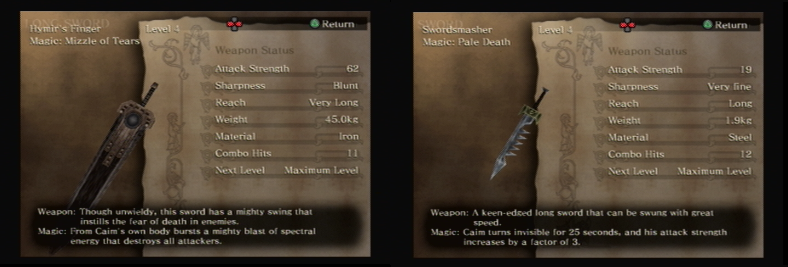

So there is a lot of potential in the weapon system but ultimately you will find a weapon that has a relatively safe combo and finisher to suit your playstyle. Finishers will generally create a shockwave or projectile at the end of your combo and typically knocks enemies to the ground. While Drakengard is generally very easy, if an enemy gets around your swing radius (which with the terrible camera is very possible) and they begin to chain stagger you into a knockdown they can shave off a considerable amount of health.
Then this reliance on a few combos and the relatively stagnant enemy formations during the first half of the main game make it a particularly mindless grind at times. Caim can sometimes speed up the process by summoning a temporary ally (a limited number of times per Verse) or hopping on the Dragon to rain down fire on the legions of empire mooks. Unless they are red and thus immune to magical dragonfire. Or if they wield an arbalest and you don’t see them in time, as their crossbows seem to change into chainguns when you have mounted the Dragon.
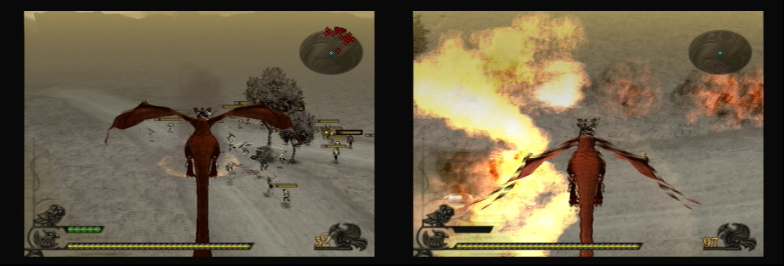
Cavia was going for an Ace Combat feeling when riding the Dragon in her own specific Sky Verses. These levels show more enemy variety earlier in the game. She can fire weak homing shots against multiple targets or a single powerful forward fireball. While these missions have more interesting enemy types earlier than the ground missions they will present their own issues to new players, such as spatial awareness. Please remember that if you are having camera issues on the Dragon you can either break the target she is auto following with Circle or swing her in the direction of that target with R2. Her missions can feel awkward, and even with the extra variety they still get repetitive. But they’re fairly manageable with practice and provide a much needed break from the ground gameplay.

Drakengard is a pretty easy game until after the first ending. There are a few difficulty spikes, most notably around any boss you encounter. There’s also a bit of RNG involved with bosses and patterns. Sometimes they would perform the same dangerous routine again and again, other times they would be a little slow to the draw and be eviscerated. They’re generally fought on the Dragon, and the biggest threat is often the camera. But bosses are a welcome break in the pattern.
Story and Characteriztion
A quality a lot of people attach to Drakengard is that while the gameplay can be lacking the theme and flavour and plot is a bit of a ride. Drakengard presents itself from the outset as a very typical dark medieval fantasy game. The evil Empire seeks to break magic seals and capture a living goddess, Caim’s sister Furiae. Caim and the valiant Union stand against the evil Empire, brave and glimmering.
But listening to Caim’s commentary during the very first mission you realize that this guy’s not just out for revenge he’s taking a great deal of pleasure in bloodletting. Your companions along the way have no shortage of observations about Caim’s cruel heart and lack of mercy as he cuts down legions of troops, sometimes even the game’s narration goading you to kill every last target. But is he capable of anything deeper?

Drakengard’s characters subvert the norm. On the surface you have the vengeful Caim, the kind music of Inuart, and Furiae committed to her role as goddess. But as you meet characters or get to learn more about them, their secrets and taboos are laid bare. Drakengard deals with sexual taboos, mental health, self harm, violence against children, and a lot of violence in general. If that’s a concern, please be aware.
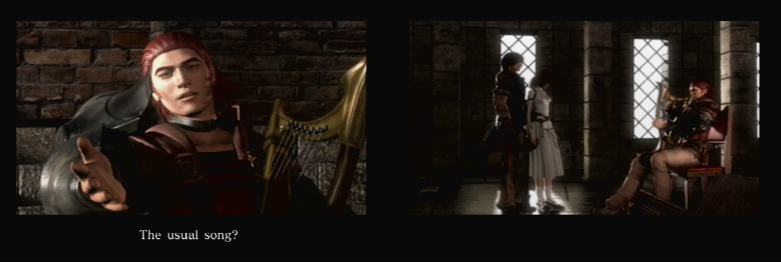
Whether or not Drakengard pulls these themes off well or not is up to interpretation. It’s often very much in your face about these, and like all games Yoko Taro was involved in it uses surface level melodrama to hide subtext. Drakengard has a lot happening when you read between the lines at times. One of the aspects of Drakengard’s development you will see is that a character like Caim was precipitated on the idea of just what kind of individual can slaughter hundreds of other sapient creatures day after day. Yoko Taro talks about that in this clip on PlayStation’s Youtube channel (At 3:15, if the timestamp doesn’t work). This is a promotional material for Drakengard 3, so beware of spoilers for that title.
As a result, these character traits are dialed up significantly in Drakengard. Are they exasperated because of the war between the Union and the Empire? Or is it through some influence of the mysterious Watchers, who are at the centre of the Cult that seems to be controlling the Empire? Is it human nature, and these caricatures meant to show us the lengths humans will go to for restitution? Is madness the real sacrifice of a Pact?
Early in the game, Caim makes a Pact with the Red Dragon. A Pact is an agreement between a humanoid and a beast, for mutual gain and power. But the greater the beast with which the Pact is made, the greater the sacrifice of the humanoid making the Pact. Caim loses his voice, and so the Dragon speaks for him and to him and conveys his thoughts. And while the Dragon holds nothing but contempt for humans, she is legitimately the most likable character in the game and I grew very fond of that smarmy spitfire.

I’m not going to outline the storyline and plot points of Drakengard but it does a similar thing as with the characters. It subverts expectations and ramps up in surprising and violent ways. Like other games in its wheelhouse it has multiple branches and endings so it’s worth playing after the first ending so that you can start to glean some more of the lore and nature of the world of Midgard and the forces that orchestrate this war.
Subversion of expectations is a common theme in Yoko Taro’s games. How many people will have bought Automata thinking it’s a surface level action game about flashy androids? How many people bought the original Drakengard thinking it was a European themed Musou? I suppose when you’ve played a lot of these games you expect that it will go against conventional expectations, though Drakengard was more of a downer than I even anticipated. This is a story about people who are often unjust and cruel, and it’s not always happy to put it bluntly.
The nature of the conflict in Midgard, this bloody war and Caim’s insistence on mass slaughter. The music scores this perfectly. Sometimes the music for cutscenes is beautiful, but most other times it’s discordant and beating and droning. It just solidifies the tone of this grim venture, and while I am used to the absolutely incredible soundtrack of NieR Gestalt/Replicant I can’t dislike the audio choices in Drakengard. It’s not easy listening, I won’t be playing most of these songs in the background, but they serve a purpose.
Even the weapons do this, the Drakengard and NieR games have “weapon stories” and Drakengard kicks this trend off strong. So if you have a favourite weapon, check its explanation and find out some of the morbid details of the stick you’re swinging around. There’s a lot of flavour here in weapon text and verse selection text and in-level character banter. A lot to absorb.
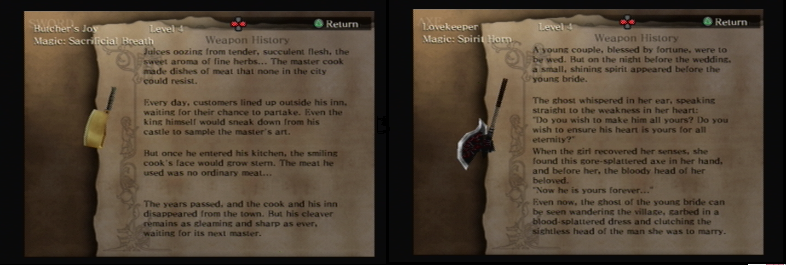
To note, Drakengard was censored in the West and so a lot of the more sensitive subjects were toned down. There are still some hints in here that you can piece together, but certain scenes are definitely neutered or even made quite confusing without context. In the incredibly unlikely even Drakengard were to ever receive a remake or remaster, I’d want every ugly facet of the story restored.
Wrapping it Up
Drakengard is a divisive game. There are people who absolutely love it. There are people who can’t stand it. And I think there will be a lot of people showing interest in this series off the back of NieR Automata and finding out that it’s just not for them. But if you’ve gotten into Yoko Taro’s work I really do urge you to give some of the older titles a chance, because there’s a lot of succulent flesh if you can just crack the shell.
I’ve seen Drakengard labelled “terrible” or “awful” or “horrible” and to be clear, it is none of those things. It’s very middling. Aside from the camera and frame rate, which are serious issues, the game works. I’ve never found it unresponsive, and it’s generally pretty straightforward. What it is, however, is lacking in gameplay variety and flavour – despite having distinct modes. As a game in the purest sense of the word it’s not good, but it’s not bad. It’s tragically average.
But even the often lauded storyline can be a strike if you aren’t feeling that. These character personalities are not going to settle down and the storyline is dark, violent, and sobering. Drakengard is the definition of “Not for everyone.” More so than probably any other game I’ve covered here. If you aren’t going to be able to tolerate the gameplay and you aren’t liking the cast or direction then it’s time to move on.
I think there are a lot of great ideas to Drakengard. It’s just that the execution isn’t always up to snuff.
In spite of all of that, I still enjoyed playing it and I definitely enjoyed soaking in the lore. Drakengard was a game I used to listen to podcasts and broadcasts, because for a lot of missions I only really needed to pay attention when someone started talking. And the only occasions I found fighting mooks truly tedious were situations like when there were 30 red shield guys in one hallway just to soak up time. In the end I didn’t dislike playing Drakengard at all, regardless of the flaws.
Hell I have one more game to find to wrap up my time with the series, Drakengard 2 which despite different direction and talent and tone I still want to play. Two Drakengards in and I want to play more, fancy that.
Drakengard is a game I’ve wanted to play for a very long time. For just as long, people have told me not to play it. But you know when someone points out a disaster it’s difficult to look away. And it’s rough around the edges, but it has a strange allure to it. I’m not going to say if this game is for you or not. But it seems it’s definitely for me.
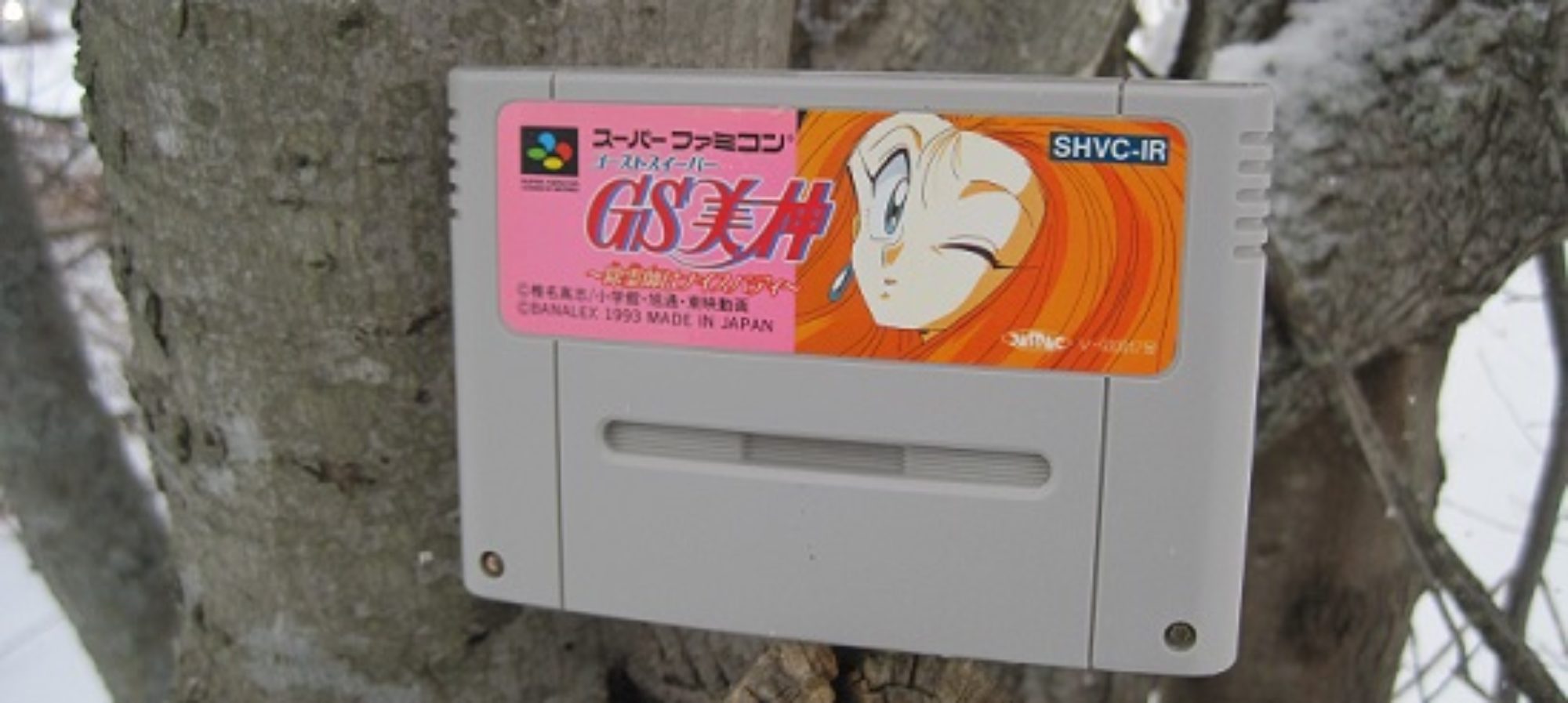

Interesting take on this, but I’m not sure if this something I’ll try. Your description of Caim is intriguing, anyway. I would love more games to have an absolutely ruthless, callous protagonist as long as they look appealing to me as well. The happy-go-lucky trope of 90% of protagonists bores me.
I’ve only played a few hours of the second years ago. I didn’t find it bad, save for the dubbing, but it would’ve been more enjoyable for me with voice acting I actually liked. It has great looking FMVs, in any case. I would try going through it again if an undubbed version of it exists, as D2 is the only one that particularly interets me.
Yeah, Caim’s absolutely bloodthirsty and I didn’t really want to get too deeply into his character here. If he had dialogue for the entire game I don’t know whether he would have become grating or not. But his character is illustrated through his actions, usually kicking someone in the face or killing hundreds of people.
The game is about troubled people in an unsavoury world. It’s a very different feel. I didn’t even get into the true nature of the Watchers or their priestess Manah. But I think at the very least you’d like the story of the game. The gameplay I don’t know how much I could recommend that anymore. But it’s worthwhile consuming the story in some format.
One of the main things people say about D2, besides Taro being absent except for some creative input, is that there was a push to make it a brighter, less depressing and more marketable game. And I don’t know necessarily how much it differs from the original in that sense but I still want to play through it at some point. The gameplay is supposed to have been improved.
If the game/gameplay really is that bland and the story is worth checking, there’s always the modern convenience of just watching via YouTube.
What I would like to see with JRPGs are ones with dynamic stories instead of the static ones in literally every JRPG. Something where you get to choose if you want to be good, neutral, or evil. The only RPG that comes to mind in general for me is Fable, and I don’t overly care to look into that more.
I guess it’s a lot more work/effort and time which presumably equates to more money to do dynamic stories. Not to mention doing it well is most likely harder than a static one. In an industry that doesn’t like to take risks, those type of stories will forever remain a fantasy, I suppose. Just saying, it would be nice though and would increase the replayabilty factor as well.
D2 wasn’t really that dark of a game storywise from what I remember, so most likely.
Yeah I’d say more bland than straight up bad. You can speed through the game to ending A, but if you want to upgrade weapons they each require certain numbers of kills to level up and (spoilers) if you want to see the branch and ending that leads to NieR tou have to find each and every weapon (which I would recommend using a guide because some of them are like “wait around 20 minutes for a box to show up” and the like)
If you want a summary of the game without watching an entire playthrough I would recommend
JordanKaiSA’s “NieR Intermission” videos: https://www.youtube.com/watch?v=oLLoL2Oqrt0
Or Clemps’ analysis videos https://www.youtube.com/watch?v=__q_Nx9WbgY
Yeah it would be refreshing to see more choices in JRPGs that have actual weight to them and help shape the overall story around the player.
I will probably never do either (play the game/watch a playthrough), but I couldn’t do the former at the moment even I wanted to. I prefer the art for the faces during cutscenes in the second one more than the CG faces used in the first… find those kinda ugly,
Yup.